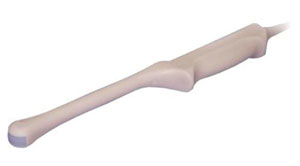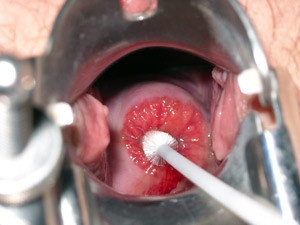Ultrasound, or scanning, also called ultrasonography, involves the use of high-frequency sound waves to obtain images of internal organs and other body structures. With ultrasound, ionizing radiation, as with x-ray examination, is not used. Since ultrasound allows you to get images in real time, the procedure helps to evaluate the structure and movement of internal organs, as well as blood flow in the blood vessels.
Ultrasound is a non-invasive study that helps doctors diagnose and treat diseases.
Ultrasound of the pelvic organs allows you to get an image of the tissues and organs located in the lower abdomen and pelvis.
Three types of ultrasound examinations of the pelvic organs are distinguished:
- Abdominal (transabdominal)
- Vaginal (transvaginal) ultrasound of women
- Rectal (transrectal) ultrasound of men
Part of the pelvic ultrasound can be Doppler.
Dopplerographic examination allows you to evaluate blood flow in the blood vessels, including the large arteries and veins of the abdominal cavity, upper and lower extremities and neck.
In what areas is pelvic ultrasound used?
In women, pelvic ultrasound is most often used to assess the condition:
- Bladder
- Ovary
- Uterus
- Cervix
- Uterine (fallopian) tubes
In addition, ultrasound is used to monitor the health and development of the fetus during pregnancy.
Ultrasound of the pelvic organs helps to identify the causes of the following symptoms that occur in women:
- Pain in the lower abdomen
- Pathological bleeding
- Other menstrual irregularities
It is also used for diagnostics:
- Palpable formations such as ovarian cysts and uterine fibroids
- Ovarian or Uterus Cancer
Transvaginal ultrasound is usually used to assess the condition of the endometrium, or the inner lining of the uterus, including its thickness, as well as the ovaries. In addition, transvaginal ultrasound is a good method for assessing the state of the muscular walls of the uterus, called the myometrium.
A more detailed study of the condition of the uterus allows such a study as ultrasonic hysterography. This study is usually used to detect:
- Anomalies in the structure of the uterus
- Scars on the uterus
- Endometrial polyps
- Fibroids
- Cancer, especially in patients with abnormal uterine bleeding
Some doctors use ultrasound hysterosalpingography to examine patients with infertility.
In men, pelvic ultrasound is used to assess the condition:
- Bladder
- Seminal vesicles
- Prostate gland
A special type of study that allows you to see the prostate gland is transrectal ultrasound, which involves the introduction of a special sensor into the rectum.
In both men and women, pelvic ultrasound helps to detect:
- Stones in the kidneys
- Bladder tumors
- Other diseases of the urinary tract
In children, pelvic ultrasound is used to diagnose the causes:
- Premature sexual development or delayed puberty in girls.
- Pain in the lower abdomen.
- Examination of hermaphroditic genitalia and other abnormalities of the structure of the pelvic organs.
- Neoplasms of the pelvic cavity.
An ultrasound scan of the pelvic organs is also used to control procedures such as puncture biopsy, during which a small tissue sample is removed from the organ for subsequent laboratory tests.
Dopplerography helps doctors see and evaluate:
- The reason for the violation of blood flow in a vessel, for example, blood clots.
- Vasoconstriction, which may be caused by atherosclerosis.
- Tumors and congenital vascular malformations.
How to prepare for the study?
You should come to the examination in comfortable, loose clothing. During the procedure, the doctor may ask the patient to wear a special shirt or bathrobe. It is necessary to remove all jewelry and clothes from the examined area of \u200b\u200bthe body.
Ultrasound examination is extremely sensitive to movements, and therefore the procedure can slow down if the child is very active or crying. The child should be told in advance about the course of the examination, which will make it possible to clothe the procedure. You can take a book to the treatment room to read to the child during the study.
The rooms of the diagnostic departments are often equipped with televisions, which can be used to distract the child in the absence of other methods.
Conducting a transabdominal ultrasound requires a tight filling of the bladder, which facilitates the visualization of the uterus, ovaries, prostate gland and bladder wall.
What does the diagnostic equipment look like?
An ultrasound scanner consists of a console, which includes a computer and electronic equipment, a video display and an ultrasound probe, which is used for scanning. An ultrasound probe is a small portable device that resembles a microphone and is attached to the scanner with a cable. The sensor sends high-frequency sound waves inaudible to the ear, which penetrate the body and, reflected from the tissues, fall back in the form of reflected signals, that is, an echo. Thus, the principle of operation of the ultrasound sensor is similar to sonar in submarines.
The ultrasound image immediately appears on the screen of the video display, which looks like a regular computer monitor. The resulting image depends on the amplitude (strength) and frequency of the sound signal, on the time it takes for the wave to return from the tissue to the sensor, as well as on the structural features of the body structures through which the signal passes.
If the ultrasound requires the introduction of a sensor into the natural openings of the body, for example, during transvaginal or transrectal examination, then the device is protected with a condom and lubricated with gel.
What is the basis of the study?
The basis of ultrasound research is the same principle as in the operation of sonar systems that are used by bats, on ships, submarines and in weather services. When a sound wave collides with an object, its reflection occurs, that is, the formation of an echo. The analysis of reflected waves allows us to assess the range of an object, its size, shape and texture (dense, liquid or mixed).
In medicine, ultrasound is used to detect changes in organs, tissues and vessels, or to detect pathological formations, such as tumors.
During the ultrasound, the sensor simultaneously sends sound waves and receives / records reflected vibrations. When the sensor presses the skin, small impulses of inaudible, high-frequency sound waves form that penetrate the body. When sound waves collide with internal organs, tissues or liquids, the ultrasound sensor's sensitive microphone captures the smallest changes in pitch and direction of sound. The obtained characteristic vibrations are constantly measured by a computer program and reflected on the display screen, which allows you to get an image in real time. As a rule, during the study, the doctor can get one or more pictures of moving structures. In addition, it is possible to record small video clips in real time.
Transrectal and transvaginal ultrasound, which requires the introduction of special sensors into the natural openings of the body, is based on the same principles.
Dopplerography is a special type of ultrasound study that allows you to measure the speed and direction of movement of blood cells in the vessels. The movement of blood cells causes a change in the height of the reflected sound wave (the so-called Doppler effect). The computer collects and processes the information received and creates graphs or color images that show the flow of blood through blood vessels.
How is the study conducted?
Transabdominal Ultrasound
In most cases, when performing an ultrasound, the patient lies on his back on the couch, which can move or bend.
Transabdominal ultrasound transducer
After that, a transparent water-based gel is applied to the skin of the examined area of \u200b\u200bthe body, which ensures tight contact of the sensor with the skin and eliminates air pockets between them, which interfere with the passage of sound waves through the tissues. Then the ultrasound diagnostics doctor who conducts the study tightly presses the sensor to the skin at various points, leading it over the examined area of \u200b\u200bthe body. At the same time, sound waves penetrate the tissues at different angles, which helps to accurately examine the desired organ.
Transvaginal ultrasound
Transvaginal ultrasound in the manner of execution is very similar to a gynecological examination and includes the introduction of a sensor into the vagina after emptying the bladder. The probe tip is smaller than standard gynecological mirrors and expanders.

Transvaginal ultrasound probe
A disposable condom is put on the ultrasound probe and a small amount of gel is applied, after which the probe is inserted into the vagina by only 4-5 cm. For a full assessment of the structure of the uterus and ovaries, images should be obtained from different angles.
Usually, transvaginal ultrasound is performed in the patient’s supine position with legs spread apart, like a gynecological examination.
Transrectal ultrasound
During transrectal ultrasound, a disposable condom is put on the ultrasound probe and a gel is applied, after which the probe is inserted into the rectum.

Transrectal ultrasound transducer
As a rule, the patient thus lies on his side, with his back to the doctor, with legs slightly bent at the knee and hip joints.
Dopplerography is performed with the same ultrasound probe.
After completing the study, the doctor asks the patient to get dressed and wait until the image analysis and the conclusion are completed.
As a rule, the pelvic ultrasound procedure takes about 30 minutes.
What should be expected during and after the study?
Most ultrasound examinations are easy, fast and painless.
With transabdominal ultrasound:
After placing the patient on the couch, the doctor applies a small amount of warm water-based gel to the skin and presses the sensor firmly against the body, starting to lead it over the area being examined in order to obtain sufficiently clear images. As a rule, the patient does not experience any unpleasant sensations, except for a small pressure in the examined area.
If the ultrasound affects the painful area, then the pressure of the sensor on the skin may be accompanied by a slight pain.
Ultrasound, which requires the introduction of a sensor into the natural openings of the body, causes certain unpleasant sensations.
With transvaginal ultrasound:
Despite the fact that the study is usually prescribed for pain in the lower abdomen, the transvaginal ultrasound procedure itself is usually painless or accompanied by minimal discomfort. In this case, the study is often less unpleasant than a gynecological examination.
With transrectal ultrasound:
If a biopsy is not required, then the procedure is generally similar to a rectal examination by a doctor, or even less unpleasant. If a biopsy is necessary, additional unpleasant sensations associated with the introduction of a needle are usually minimal, since the wall of the rectum in the prostate gland is relatively insensitive to pain.
A biopsy can lengthen the procedure as a whole.
When conducting Dopplerography, you can hear pulsating sounds, the height of which changes as you track blood flow and measure its parameters.
After the procedure, the gel can be wiped off the skin.
After an ultrasound, it is immediately possible to return to the usual life activity.
Who studies the results of the study and where can I get them?
The analysis of images is carried out by an ultrasound diagnostics doctor who specializes in conducting such studies and interpreting their results. As a rule, the main education of the doctor is radiological. After studying the images, the ultrasound diagnostics doctor draws up and signs a conclusion, which is sent to the attending physician. In some cases, the conclusion can be taken from the doctor of ultrasound diagnostics, as well as discuss the results of the examination with him.
A follow-up examination is often required, the exact reason for which the patient will explain to the attending physician. In some cases, an additional examination is carried out upon receipt of doubtful results that require clarification during repeated procedures or the use of special imaging techniques. Dynamic observation allows you to identify any pathological deviations that occur over time. In some situations, re-examination allows talking about the effectiveness of treatment or stabilization of the tissue over time.
Benefits and risks of pelvic ultrasound
Benefits:
- Ultrasound is non-invasive (does not require injections) and, in most cases, is a painless procedure.
- Ultrasound is a fairly simple, widely available and less expensive method of examination, compared with other imaging techniques.
- Ultrasound does not imply the use of ionizing radiation.
- Ultrasound scanning allows you to get a clear image of soft tissues, which are not visible during x-ray examination.
- Ultrasound is the preferred imaging method for monitoring the health and development of the fetus during pregnancy.
- Ultrasound provides an image of tissues in real time, which allows you to use it with such minimally invasive procedures as puncture and aspiration biopsy.
- Ultrasound of the pelvic organs helps to diagnose a wide variety of diseases of the urinary tract and reproductive system in patients of both sexes without the slightest risk associated with an X-ray examination.
Risks:
- Standard diagnostic ultrasound is free of any unwanted effects.
What are the limitations of pelvic ultrasound?
If there is air or gas, the sound wave is disturbed. Therefore, ultrasound is not suitable for examining organs filled with gases, as well as organs that are hidden by intestinal loops. In most of these cases, a study with a suspension of barium, MRI or CT scan is prescribed.
Ultrasound is difficult in large and obese patients, since a large amount of muscle and adipose tissue weakens the sound wave as it penetrates deeper into the body.
In cases of the appearance of abdominal pain and other symptoms, indicating violations in the digestive, urinary or other systems of the body, the doctor may prescribe an ultrasound examination of one or another organ. As a rule, the question of where to make an ultrasound of the abdominal cavity does not arise - directly in the clinic there is a well-equipped office with the necessary equipment.
What is examined during abdominal ultrasound?
The study determines the condition:
- liver
- gallbladder;
- kidney
- spleen;
- pancreas;
- abdominal aorta;
- organs located in the pelvis.
Ultrasound of the abdominal cavity, the price of which is quite affordable for each patient, shows the presence or absence of stones in the gallbladder or kidneys, the presence or absence of tumors, the condition of one or more organs, the presence of an inflammatory process, etc. This is an important study on which the doctor relies when diagnosis or determining the upcoming treatment process.
Gynecological ultrasound
In order to determine the state of the female reproductive system, it is often necessary to do an pelvic ultrasound scan. This is one of the most common gynecological studies, which gives the doctor the opportunity to confirm or refute his suspicions about a gynecological disease. Using ultrasound of the uterus and appendages determine:
- inflammatory diseases;
- cysts, fibroids and other neoplasms;
- ectopic pregnancy;
- mutual arrangement and condition of reproductive organs.
In addition, an ultrasound of the uterine cavity is mandatory several times during pregnancy. With its help, doctors evaluate the development of the child and can identify developmental pathologies at sufficiently early stages. The cost of pelvic ultrasound is minimal, and the benefits that this study brings are simply invaluable.
How is ultrasound performed?
Ultrasound examination of internal organs absolutely does not cause pain and does not bring the slightest harm to the body. Before an ultrasound, in some cases it is necessary to follow a diet or drink a certain amount of liquid. To conduct the study, the doctor puts the patient on a couch, applies a special gel to the skin of the abdomen, after which he examines the necessary areas of the abdominal cavity or small pelvis with a scanner, tightly pressing it to the patient's skin.
Women are sometimes prescribed pelvic ultrasound transvaginally, for which a scanner is inserted into the vagina. This examination is often prescribed for obese patients, since ultrasound waves cannot pass through the fat layer of the abdominal wall. At the same time, the ultrasound of the appendages is carried out in the usual transabdominal way, i.e. through the front wall of the abdomen. If it becomes clear that an additional examination of the fallopian tubes is necessary, the doctor may additionally prescribe hysterosalpingography, which with high accuracy shows the presence of adhesions and the patency of the tubes.
The page is for informational purposes only. Find out the exact list of services provided and the features of the procedure by phone.
Ultrasound in gynecological practice is very widespread. For what purpose is an abdominal pelvic ultrasound performed, which is required for this procedure. What results can the study show.
The essence of the procedure
Abdominal ultrasound of the pelvic organs is performed in cases where it is not possible to examine the internal genital organs using a transvaginal sensor. Such situations occur in the presence of intact hymen or pathologies that impede passage through the vagina.
Ultrasound is performed using a conventional abdominal transducer. Subject to certain rules, the information content of this method is no lower than when using a transvaginal sensor.
The study is carried out using an abdominal sensor when it is not possible to use transvaginal
Indications
An abdominal pelvic ultrasound is prescribed in the following situations:
- suspicion of an inflammatory process in the uterine cavity or appendages;
- inflammatory diseases of the bladder;
- suspected cyst / ovarian cysts;
- inflammatory processes in the kidney tissue;
- cystic formations and tumors of the kidneys;
- omission of the kidney;
- determination of the degree of uterine fibroids;
- diagnosis of endometriosis;
- confirmation of pregnancy.
If it is impossible to carry out a transvaginal examination, the way out of the situation will be the use of an abdominal sensor. In men, an abdominal ultrasound scan can be used to diagnose adenoma or malignant prostate tumors.
Ultrasound Preparation
To create better visibility and increase the effectiveness of the examination, the patient is offered to prepare in a certain way. What is the preparation?
- Three days before the proposed ultrasound, you should refrain from eating cabbage, rye bread, berries and fruits, and fresh pastries. All of these products can cause increased gas formation, as a result of which the intestinal loops swell and impede visualization.
- On the eve of the study, several tablets of Espumisan and sorbents should be taken.
- In the evening, a cleansing enema is done or a laxative in the suppository is administered.
- Immediately before the ultrasound, the patient needs to drink at least a liter of water and refrain from visiting the toilet. With a full bladder, the internal genitalia are much more visible.

One of the stages of preparation for ultrasound is taking Espumisan - to reduce gas formation
Technique
Ultrasound diagnostics are carried out in a specially equipped room. The patient is offered to undress to the waist and lie on the couch. The test is usually done while lying on your back, but your doctor may suggest that you turn on your right or left side. A special gel-conductor is applied to the skin of the abdomen. It improves the quality of the ultrasonic signal, which helps to increase information content. Then the doctor will conduct an abdominal sensor along the lower regions of the anterior abdominal wall. The ultrasound procedure is safe and painless.
The procedure usually lasts 10-15 minutes. After that, the diagnostician examines the data and issues a conclusion. This conclusion is evaluated by the attending physician and on his basis he makes a diagnosis.
What can be seen
With ultrasound, you can see a variant of the norm and various variants of the pathology.
- Normal ultrasound picture of the pelvic organs - the uterus of the correct form, the corresponding sizes, with muscular walls, sufficient on thickness. The pipes are passable, at their distal ends rounded formations are found - the ovaries. The endometrium is even, its thickness corresponds to the phase of the menstrual cycle.
- Pregnancy is also a variant of the norm - in this case, an attached fetal egg is found in the uterine cavity. The minimum number of ultrasound examinations during pregnancy is three.
- Inflammation of the uterus and appendages - the endometrium is thick, loose, there are bumps.
- Polyp is an outgrowth of the endometrium of various sizes and shapes.
- Uterine fibroids - the presence in the muscle wall, on the mucous membrane or on the serous membrane of one or more nodes.
- Pipe pathology - narrowing of the lumen, the presence of adhesions, twisting of the pipe. Presence of a fetal egg in the fallopian tube.

With pelvic ultrasound, you can see many pathologies - for example, uterine fibroids
The information content of abdominal pelvic ultrasound reaches 90%. You can use this procedure in any medical institution - in the direction of a doctor or on your own.
Ultrasound is completely harmless to humans. This factor is of particular importance in ultrasound of the pelvic organs, in the cavity of which the bladder, the prostate in men and the uterus with appendages in women are located. During the examination, not only organs are examined, but their blood circulation is also evaluated.
Based on the results, the conclusion of the study is derived, on the basis of which the alleged diagnosis of the doctor is confirmed or refuted. Ultrasound examination refers to objective diagnostic methods - the images obtained can be evaluated by doctors from different countries and make their own conclusions.
Cost of services
Ultrasound diagnostics are performed by experienced doctors
Universality and effectiveness of the pelvic ultrasound procedure
If the clinical situation requires it (for example, monitoring the position of the catheter in the bladder or inside the uterus), pelvic ultrasound can be done several times a day - unlike the X-ray diagnostic method, which cannot be repeated earlier than after six to twelve months. Ultrasound scanning is performed for both men and women, infants and the elderly.
Advantages of the technique:
- painlessness - no pain relief required;
- non-invasiveness - examination of the internal organs is carried out without penetrating the pelvic cavity using surgical instruments;
- informativeness - internal organs, as well as foci of pathologically altered tissues are reflected in the pictures;
- accessibility - prices are several times lower than similar studies using CT and MRI.
Indications for ultrasound of the pelvic organs
Indications for ultrasound scanning can serve as patient complaints and the need to clarify the diagnosis. Research in some cases is the only possible diagnostic method. The procedure is necessary for girls and women who do not have sex - a vaginal examination on the armchair is contraindicated. Ultrasound diagnosis in childhood indicates the cause of the appearance of pain in the pelvis with neoplasms.
Using ultrasound, the signs of abnormalities of the development of the pelvic organs are determined and the presence of hermaphroditic genitals is revealed, the causes of premature puberty or developmental delay, which may be due to a hormonal tumor, are clarified.
 Pelvic ultrasound is prescribed for the following complaints:
Pelvic ultrasound is prescribed for the following complaints:
- pains in the lower abdomen;
- urination disorders;
- erectile dysfunction;
- menstrual irregularities;
- inability to conceive a child;
- for routine inspection before IVF procedure.
Ultrasound is also performed to examine the pelvic organs after surgery or to monitor therapeutic treatment, including after a course of chemotherapy. With the help of the study, it is possible to determine vascular pathology in pelvic pain syndrome.
Types of ultrasound as a method of diagnostic examination of the pelvic organs
There are differences in ultrasound diagnostics for access to the examined area. The procedure is carried out in several ways:
- transabdominal - when examined through the anterior abdominal wall;
- transvaginal - the sensor is located in the vagina;
- transrectal - the sensor is inserted into the rectum.
The transabdominal method is the most common, it is used in almost all patients, regardless of age and gender.
The transvaginal ultrasound technique is performed in women who have sex. The sensor is inserted into the vagina, which provides a clear image of the pelvic organs without the additional condition of filling the bladder. In addition, with a vaginal ultrasound examination, the cervix is \u200b\u200bvisible, inaccessible for examination with abdominal access.
Transrectal access is used in men to examine the prostate, which is located at the bottom of the pelvis and fits snugly into the rectum. With this access, the presence of a rectovaginal fistula is checked in women.
According to the technique of ultrasound, it differs in the usual scanning and examination of the vessels of the pelvic organs using dopplerography. The Doppler effect allows you to evaluate the speed of blood flow, therefore, to assess the degree of oxygen starvation - hypoxia. Dopplerometry also determines the degree and place of narrowing of the vessel, as well as the cause of the decrease in blood flow - the formation of vascular plaques or parietal thrombi.
Preparation for the pelvic ultrasound procedure
In order not to affect the information content of the examination, it is necessary to prepare for the procedure. With the rectal method, it is recommended to make a cleansing enema to free the rectum. The vaginal method does not require any preparation, while a condom is put on the sensor. With the transabdominal method, it is necessary to fill the bladder, which serves as a screen for ultrasonic waves.
The benefits of pelvic ultrasound in the "Medical and Diagnostic Center on Vernadsky"
In the "Medical and Diagnostic Center on Vernadsky" you can do an ultrasound of the pelvic organs at prices not higher than average in clinics in Moscow. Our experts conduct research - both as prescribed by the doctor, and on the patient's own initiative. After the end of the procedure, a person has the opportunity to immediately contact a specialist of our center and get competent advice and recommendations on treatment.
The advantages of the used ultrasound machine

- An ultrasound scan using the Philips HD15 apparatus (Philips SHD15) allows you to receive high-quality and timely diagnosis of diseases at the earliest stages, which helps to prescribe competent treatment to achieve a positive result.
- The equipment is compact and mobile, while ensuring high image quality.
- The highly sensitive sensor practically does not require subsequent adjustment according to the type of study due to automated optimization.
- The device is universal and widely used in practical work.
Our advantages:
- All employees undergo retraining annually.
- Diagnostic devices of an expert class.
Philips Intera 1.5T and Philips HD10








